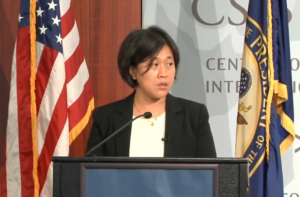Over eight months after taking office, the Biden administration is ready to begin outlining its China policy, the result of a months-long internal review process. The public-facing reveal began with U.S. Trade Representative Katherine Tai’s speech on Monday at the Center for Strategic and International Studies in Washington, D.C.
Her speech, as Tai put it, was meant to “lay out the starting point of our Administration’s strategic vision for realigning our trade policies towards China to defend the interests of America’s workers, businesses, farmers and producers, and strengthen our middle class.” But the speech itself, as well as Tai’s answers in the ensuing question-and-answer session, was frustratingly vague and lacking in specifics.
One thing was clear: The Biden administration is not happy with China’s current trajectory on economic issues. “Beijing has doubled-down on its state-centered economic system,” Tai said. “It is increasingly clear that China’s plans do not include meaningful reforms to address the concerns that have been shared by the United States and many other countries.”
The Biden administration’s immediate response to its frustrations with China, however, has little to do with China policy. Tsai made clear that the most important steps to take will be domestic. She stressed “investing in our workers and our infrastructure,” for example by “[r]epairing our roads and bridges, modernizing our ports, and delivering expanded broadband,” as the primary focus.
Second, the administration intends to continue its focus on resolving trade issues between the United States and its friends – what Tai called “finding a way to manage our own differences between us” in the Q&A – and standardizing approaches to “non-market practices” (i.e., China’s trade and economic policies).
But in terms of China policy specifically, the only clear commitment Tai made was to hold “frank conversations” with her Chinese counterpart to discuss implementation of the Phase One trade agreement, which was reached by the Trump administration and China in January 2020. (Incidentally, Tai mentioned that she personally doesn’t like the unofficial “Phase One” moniker because of the “expectations issue” – the implication of a follow-up “Phase Two” and beyond.)
“While commitments in certain areas have been met, and certain business interests have seen benefits, there have been shortfalls in others,” Tai said.
Bill Reinsch, senior adviser and Scholl Chair in International Business at CSIS, tried repeatedly during the Q&A to get Tai to specify areas where the USTR sees China as having fallen short of its commitments in the deal. Tai, however, refused to point to any specific provisions. Even the question of who Tai was looking to talk to on the Chinese side was left unanswered. (In a previous virtual meeting in May, Tai spoke with Vice Premier Liu He, China’s point man on trade talks with the previous Trump administration.)
Meanwhile, on the question of tariffs, Tai responded to a question about possible Section 301 investigations – the rationale used by the Trump administration to place tariffs on a wide range of Chinese produces – by saying only that USTR has “all kinds of tools available” to deal with problems in the economic relationship. In effect, she refused to rule out future tariffs but didn’t convey enthusiasm for them, either.
In fact, Tai confirmed that the Biden administration was “restarting the tariff exclusion process” to allow U.S. firms to seek exemption from certain tariffs on Chinese products. “We place a lot of weight in what we hear from our businesses, especially our small and medium-sized businesses” that have been impacted by tariffs, Tai said. However, she did not signal the imminent removal of any tariffs, either.
While the possibility for more tariffs was left open, the Biden administration seems more likely to use carrots rather than sticks to get U.S. companies to diversify their supply chains away from China. Tai mentioned the importance of “incentives” in securing supply chains several times, saying the goal is to “incentivize resilience, as opposed to just efficiency.” She noted, however, that she did not think full decoupling – in the sense of severing trade on key supply chain components – was “a realistic outcome.” Instead, she proposed the term “recoupling” to describe the process of creating “a trade relationship with China where we are occupying strong and robust positions in the supply chain.” It’s a question of “trade” vs “dependency,” Tai said.
As for the United States’ regional trade policy, that also was left mostly undefined. When asked if the Biden administration was interested in revisiting U.S. participation in the CPTPP – which China just applied to join last month – Tai again refrained from giving a direct yes or no, but implied that the trade agreement was outdated.
“The TPP… was something that was negotiated several years ago now,” Tai said. “…[T]he world economy has shown us realities in the intervening years that I think we really have to pay attention to.”
In other words, don’t expect the U.S. to join CPTPP in its current form. But what U.S. Indo-Pacific trade policy will look like is largely a blank slate.

































